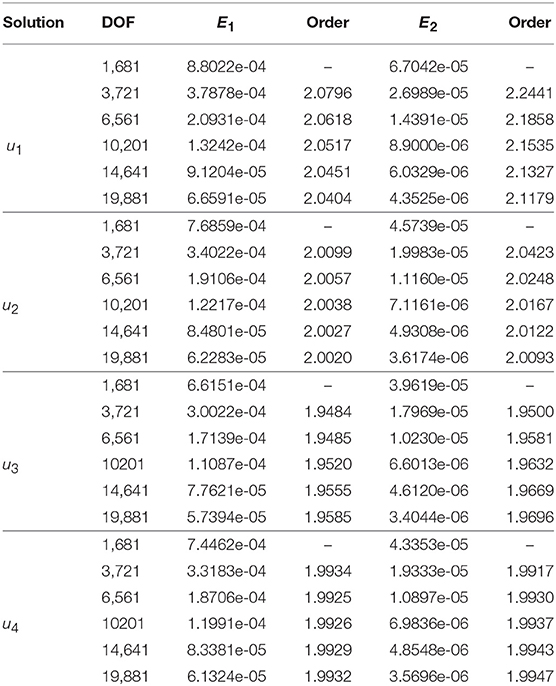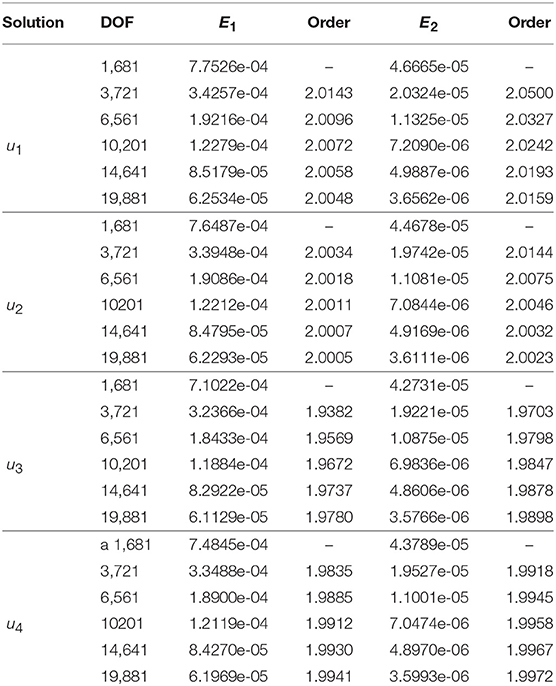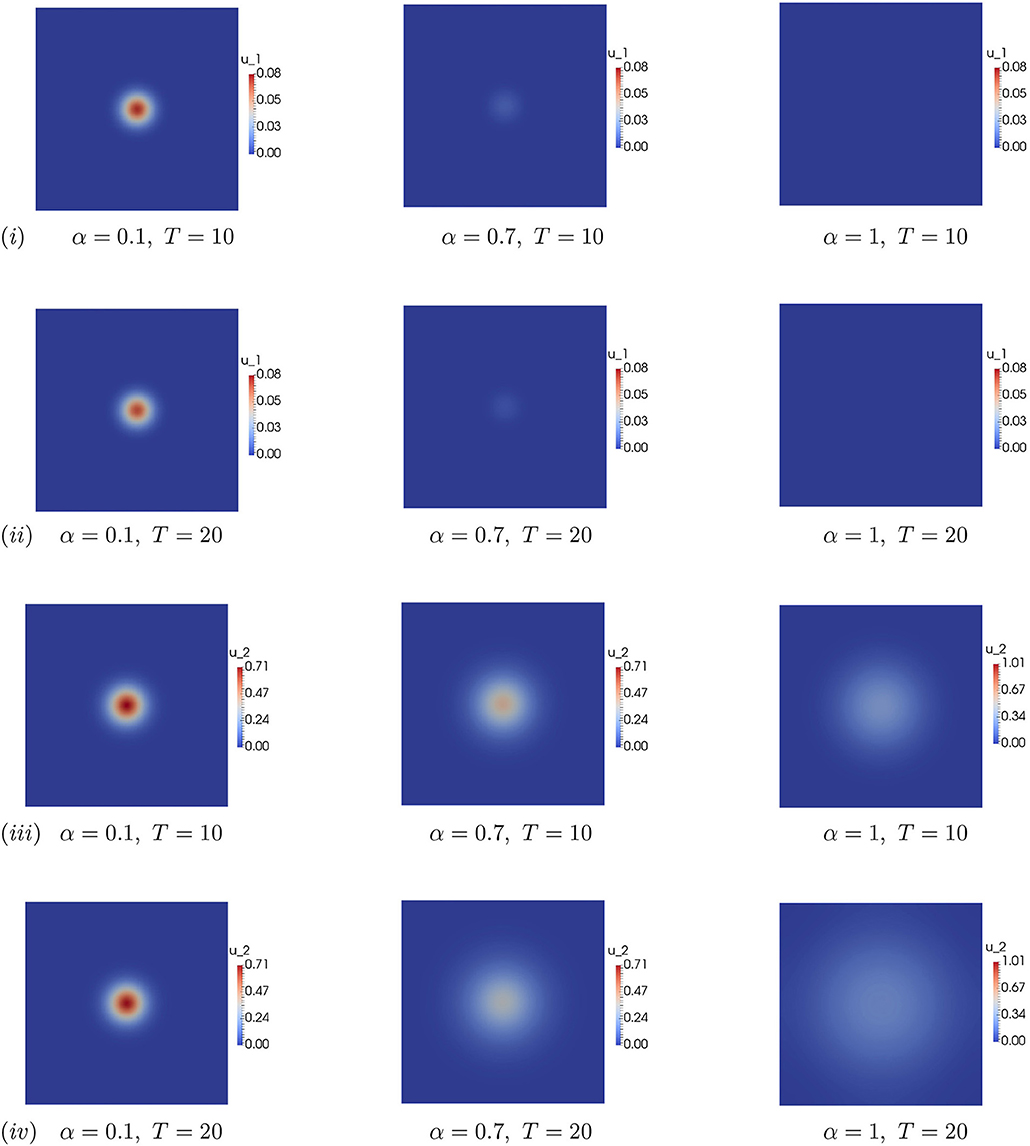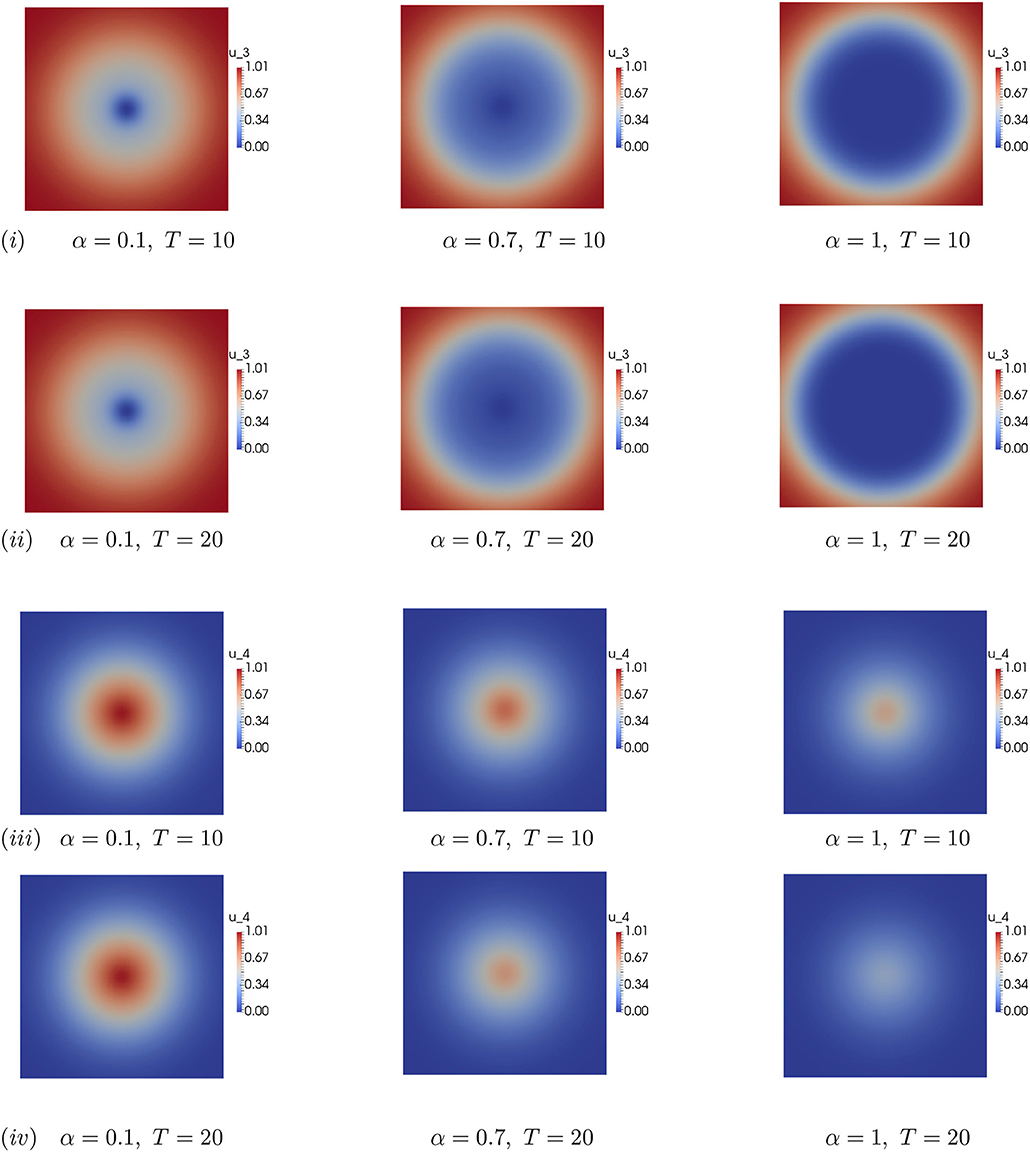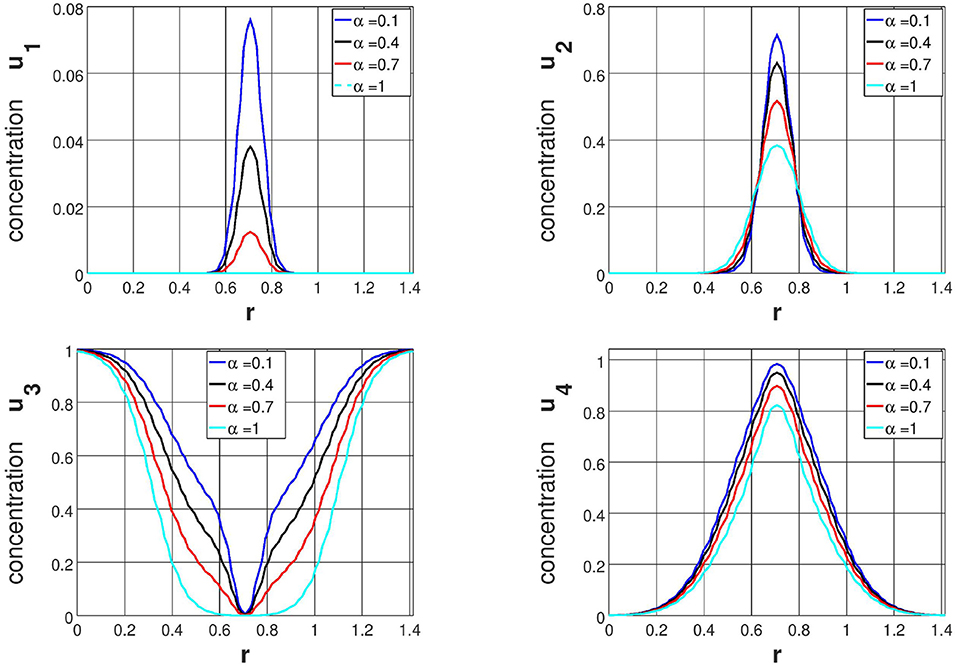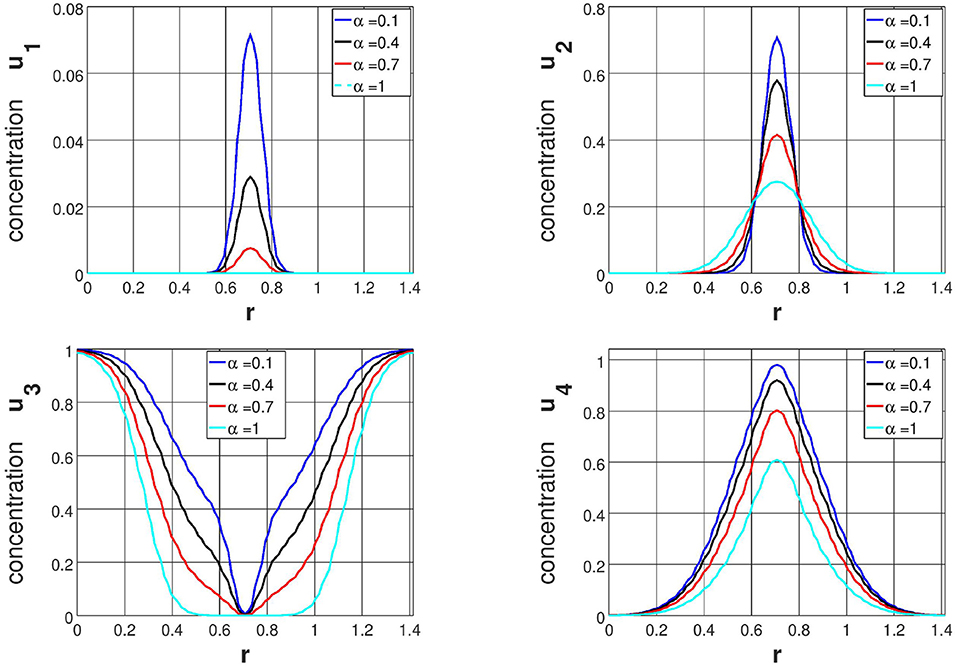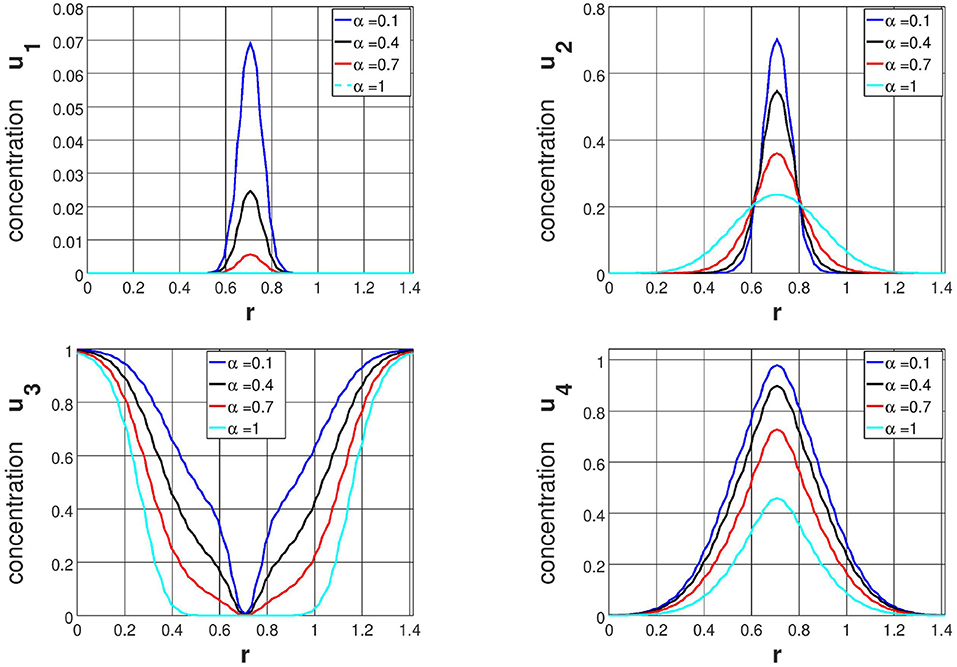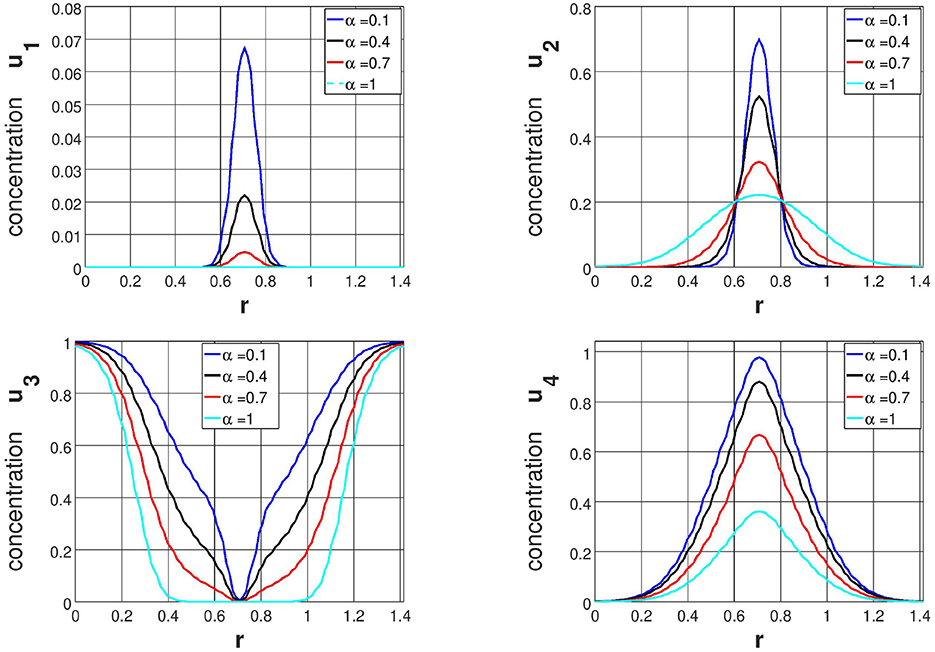- 1Department of Applied Sciences, National Institute of Technology Goa, Goa, India
- 2Department of Mathematics, Guelma University, Guelma, Algeria
- 3Department of Mathematics, Peter the Great Saint Petersburg Polytechnic University, Saint Petersburg, Russia
This article studies the existence and uniqueness of a weak solution of the time-fractional cancer invasion system with nonlocal diffusion operator. Existence and uniqueness results are ensured by adapting the Faedo-Galerkin method and some a priori estimates. Further, finite element numerical scheme is implemented for the considered system. Finally, various numerical computations are performed along with the convergence analysis of the scheme.
1. Introduction
In the past few decades, a large number of mathematical models have been applied for biological studies. In addition, mathematical models give a deeper conceptual understanding of behavioral dynamics of complex systems. Some of the advantages of mathematical models include cost efficient experiments, which can be performed speedily without disturbing biological variants. Cancer is a disease defined by a normal cell which starts replicating out-of-control. Over the years, cancer modeling has gained popularity with applied mathematicians because of its challenges, resulting in numerous research findings on the dynamics of tumor invasion. Some of these propositions are available in the literature to acquaint oneself with the developments in cancer modeling (see for instance [1–4]).
On the other hand, fractional differential equations (FDEs) have been extensively used for constructing biological models and other areas of science and engineering. We refer the following monographs [5–7] and research articles [8–12] that have explored recent developments using FDEs. Biological phenomena have an anomalous diffusion property which includes heterogeneous systems that are witnessed in porous materials (see for example [13, 14]). Linear and nonlinear models of anomalous diffusion, which have been experimented by researchers could not do justice to the biological phenomena. But the fractional models have contributed to replicate the biological phenomena with a greater accuracy. Diffusions in biological tissue has characterized as anomalous. Therefore, it has been shown to be best described using fractional calculus tools. It means equations involving non-integer derivatives and integrals. Cancer models adapting fractional differential equations are studied by Ahmed et al. [15] and Iyiola and Zaman [16] and also see the references there in.
Theoretical and numerical analysis of fractional partial differential equations (FPDEs), concerned with only very few articles, are available in the literature. Alikhanov [17] applied the method of energy inequalities to obtain the existence of solutions for a time-fractional boundary value problem of the diffusion-wave equation. Jiao and Zhou [18] established an existence result for a fractional boundary value problem with the application of the critical point theory. Further, Zhou et al. [19] analyzed the time-fractional reaction-diffusion equation under nonlocal boundary condition. Zhou and Peng [11] established the existence, uniqueness and regularity of time-fractional Navier-Stokes equations. Further, they ensured the existence of weak solutions and also provided the sufficient conditions for optimal controls in Zhou and Peng [12]. Finite volume method [20–22], meshless method [23, 24], finite difference method [25–28], finite element method [29–31] and the spectral method [32–35] are widely preferred numerical methods in the literature to solve fractional partial differential equations. Finite element methods have become popular for numerical simulations of time-fractional diffusion equations due to their good approximation and feasibility to work with any domains. Recently, Esen et al. [36] studied the numerical solutions of time-fractional diffusion equations and diffusion-wave equations using Galerkin finite element method. Jin et al. [29] analyzed the numerical solutions of multiple time-fractional derivative using the Galerkin finite element method. Wang et al. [37] combined second-order time approximation with the finite element method to solve nonlinear fractional Cable equation. Liu et al. [38] used fully discrete mixed finite element scheme to study the second order convergence for nonlinear time-fractional diffusion problem with fourth-order derivative term. Jin et al. [39] solved proposed Crank-Nicolson-Galerkin finite element scheme to solve the linear time FPDEs. Kumar et al. [40] proposed Crank-Nicolson-Galerkin finite element scheme to solve the time-fractional nonlinear diffusion equation using Newton's algorithm. However, according to author's knowledge there is no paper available in the literature to study the fractional order cancer invasion system using finite element method.
Recently fractional reaction-diffusion systems are applied for many applications in science and engineering. Fractional models are proposed and used in chemical reactions, propagation phenomena, transport systems, pattern formation processes and spatiotemporal distribution of species [41–45] and references therein. In this connection, we are interested to study and analyze the time-fractional cancer invasion model with nonlocal diffusion operator. Existence and uniqueness of a weak solution and various numerical simulations are presented for the below considered model. We considered a mathematical model proposed in Solis and Delgadillo [46] with four unknown variables namely two cancer cells density, normal cells density and acidification medium concentration. Further, we extend the same model for fractional differential equations and we show the importance of fractional derivatives using numerical simulations. The dynamics of cancer invasion system with time-fractional is governed by the following nonlocal diffusion system:
with initial and boundary conditions
where QT = Ω × (0, T), ΣT = ∂Ω × (0, T), T > 0 is final time and α ∈ (0, 1]. Here, Ω is a bounded domain in ℝN with smooth boundary ∂Ω. The unknown functions u1(x, t) and u2(x, t), respectively, describe the density of two types of cancer cells. Further, u3(x, t) and u4(x, t), respectively, represent the density of normal cells and medium acidification concentration due to excess H+ ions. The constants β1 and β2, respectively, denote the rates of interaction and the positive constant ρ delineates the intrinsic mutation rate of cancer cells. Furthermore, γ1 and δ1 represent the rate of consumption of cancer cell populations. The proliferation rate of cancer cells is given by r2 ≥ 0 and r3 ≥ 0. Here, ξ represents the production rate of the H+ions. Moreover, γ2 and δ2, respectively, denote the interaction rate of two types of cancer cells with normal cells and σ denotes the degradation rate of normal cells due to acidification. In (1.1), the diffusion rates di: ℝ → ℝ are the Lipschitz continuous functions with di(ξ) ≥ mi > 0 where i = 1, 2, 4. Further, di, i = 1, 2, 4 are taken to be depend on the whole of each population in the domain rather than on the local density. From a physical point of view of biological models, especially migration of cancer cells through normal cell is more like movement in a porous medium. Therefore, we consider the cell random motility to be a function of unknowns, see for example Szymańska et al. [47]. Therefore, it is more realistic to work with density dependent diffusion like nonlocal diffusion instead of linear diffusion function. Further, we assume that linear continuous nonlocal operator l(s) ∈ xs(L2(Ω))′ where s ∈ ℝ. This work investigates existence and uniqueness of a weak solution and numerical solutions for the time-fractional cancer invasion system (1.1).
It should be remarked that throughout the paper, we use the Caputo sense fractional derivatives for time. The main advantage the Caputo derivative, we can use initial conditions as in integer order derivatives. However, for more details we refer the interested readers to the book [48].
The rest of the manuscript is arranged as follows. In section 2, we present some preliminaries of fractional calculus and existence and uniqueness of weak solution of (1.1) using the Faedo-Galerkin approximation method and priori estimates. In section 3, we give the variational formulation of (1.1), finite element discretization and temporal discretization. Finally, in section 4, we present the convergence study of the numerical scheme and some computations with various numerical experiments.
2. Existence and Uniqueness
The goal of this section is to prove existence and uniqueness of a weak solution of nonlocal density dependent diffusion cancer invasion parabolic system with time-fractional derivative (1.1). By adopting the Faedo-Galerkin approximation method and deriving uniform a priori estimates for approximation solution, we show the existence of a weak solution in appropriate solution space. Here, we use the same notations and definitions as in Zhou et al. [19, 49]. Further, in order to avoid too many notations, we use a generic constant C instead of different constants.
Theorem 2.1 ([6]). Consider the fractional ordinary differential equation (FODE)
where 0 < α < 1 and b0 ∈ ℝ be a given constant. Suppose U be an open and connected set in ℝ and Ω = [0, T] × U. Assume that f(x, y):(0, T) × U → ℝ be a continuous function satisfying the Lipschitz condition. Then for any (x0, y0) ∈ Ω, there exists h > 0 such that the real interval [x0 − h, x0 + h] ⊂ (0, T) and there exists a unique solution u(x): [x0 − h, x0 + h] → U for (2.1) such that u(x) ∈ C[x0 − h, x0 + h], and for any x ∈ [x0 − h, x0 + h].
Lemma 2.1. Suppose u:[0, T] → X where X: = L2(Ω) is a real Hilbert space. Assume that there exists fractional derivative of u in the Caputo sense, then the following inequality holds true:
Lemma 2.2. Let α ∈ (0, 1) and a non-negative integrable function c1(t) for t ∈ [0, T] satisfies the inequality
for almost all t ∈ [0, T]. Then
Lemma 2.3 ([50], p.9). Let α ∈ (0, 1). Suppose u, v are two integrable functions, v is nondecreasing and g is a continuous function in [a, b]. If
then
where Eα(·) is one parameter Mittag-Leffler function.
Lemma 2.4. Let α ∈ (0, 1). Suppose u(·) is a non-negative, absolute continuous function on [0, T], which satisfies for a.e. t the following differential inequality
for constant C ≥ 0. Then
Proof. From (2.4),
where we use the Lemma 2.2 Using the Lemma 2.3, we get
Assume that X0, X1, X are Hilbert spaces. The Fourier transform of u : ℝ → X1 is defined by (See [51]). Then, we have
For 0 < α ≤ 1, define a Hilbert space
endowed with the norm
For any set J ⊂ ℝ, define a subspace of (see p. 274, [49]) as with support contained in J:
Further, we use the space
throughout the article.
Theorem 2.2 ([51]). Assume that X0 ↪ X ↪ X1 is continuous and X0 ↪ X is compact. Then for any bounded set J and α > 0, is compact.
Without loss of generality, we rewrite the nonlocal density dependent diffusion cancer invasion parabolic system (1.1) with time-fractional derivative in the following form:
where
Theorem 2.3. Suppose the initial conditions uj,0, j = 1, 2, 3, 4 are in L2(Ω). Then the system (2.5) admits a weak solution u1, u2, u3, u4, which satisfies the following conditions:
such that for every
Now, we use the following regularized system in order to find weak solutions of the system (2.5). For ϵ > 0,
with initial and boundary conditions
where
We apply the Faedo-Galerkin method to solve (2.7). Let {el} be a denumerable orthogonal base of orthonormal with respect to L2(Ω). We consider the sequence of finite dimensional spaces Sn = span {el, l ≤ n}. Let be the weak solution of system (2.7), where cj,n,l(t), j = 1, 2, 3, 4 are unknowns of the nonlinear FODE system,
for all em ∈ Sn. Thus, we get
Further, it is east to see that all are continuous functions of cj,n,l(t). From the Theorem 2.1, the system (2.9) has a local solution cj,n,l(t), j = 1, 2, 3, 4 on some interval [0, tn), 0 < tn < T. The extension of these solutions to the whole interval [0, T] is a consequence of the following apriori estimates.
Lemma 2.5. Assume the hypothesis of Theorem 2.3. Then there exists a constant C > 0 is independent on n such that
Proof. Now, we set . the coefficients {b j, n, l}, j = 1, 2, 3, 4. are absolutely continuous functions. Then, from (2.8), the Faedo-Galerkin approximation solution satisfy the following weak formulation
Choosing , respectively, in the above system (2.11) and summing the resulting terms, we get
where C is the positive constant which does not depend on n and t. Further, using the Lemma 2.3, we have,
for some positive constant C depending only on the given data and independent of n. From (2.12), we get
Using the results (2.12) and (2.13), we get
Lemma 2.6. Assume the hypothesis of Theorem 2.3. Then is bounded set of , where
Proof. In order to prove the result, Theorem 2.2 with Lemma 2.5, we have to show that
for some γ > 0, where denote the Fourier transform of .
Now, rewritten is defined as in (2.7),
where is defined as in (2.15),
Here δ0 and δT denote the Dirac distribution at 0 and T. Indeed, it is classical that since ũm has discontinuities at 0 and T, the Caputo derivatives of ũn is given by Zhou and Peng [12] and Zhou et al. [19]. Substitute , respectively, in (2.11), and using the Fourier transform, we get
It is obvious that the boundedness of solution shows that,
where C > 0 is a positive constant. On account of is bounded set in L∞(0, T; L2(Ω)), we get
and from (2.18), we get
For γ fixed, , we see that
Accordingly
Applying the Parseval identity, the first integral is bounded as n → ∞, and we have to prove that
From the Schwarz inequality, we prove (2.19) as follows.
the first integral is finite due to . On the other hand, it follows from the Parseval identity that
From the above integral, we understand that (2.19) is true. Thus, is bounded set of .
Theorem 2.4. Suppose the hypotheses of Theorem 2.3 hold true, then the regularized system (2.7) possesses a weak solution , which satisfies the following conditions:
such that for every
Proof. By Lemma 2.5, Lemma 2.6 and Theorem 2.2, we can extract the subsequences of such that as n → ∞, we get
It is enough, we show that
Since dj is continuous functions, it is enough to show that
Now,
This result concludes that
Substitute ϕ1,n = v and integrate the first equation of (2.11) from 0 to t and 0 to t0, respectively. Then, subtract the resulting equation, we get
Using the Lemma 2.6 and the Lebesgue dominated convergence theorem, we can prove that as t → t0 as in Zhou and Peng [12] and Zhou et al. [19]. Similarly, it can be show that as t → t0, as t → t0 and as t → t0.
Now, we prove the Theorem 2.3 and some priori estimates and compactness results.
Lemma 2.7. Assume that the assumptions of Theorem 2.3 are satisfied, then
Proof. Let us presume . Multiplying the first equation (2.7) by and integrating over Ω, we get
Using the assumptions of the given data, we get
This concludes that the solution is a nonnegative solution. Similarly, we can claim that solution are nonnegative. We prove (2.20) as in Lemma 2.5, by replacing by
Lemma 2.8. Assume the hypothesis of Theorem 2.3 are hold true. Then is bounded set of , where
Proof. As similar as proof of the Lemma 2.6.
Proof of Theorem 2.3: From Lemma 2.7, Lemma 2.8 and Theorem 2.2, we understand that sequences have convergent subsequences which are still denoted by . Then there exists (u1, u2, u3, u4) as n → ∞, we get
This concludes the proof of the Theorem 2.3.
Theorem 2.5. The solution (u1, u2, u3, u4) of system (1.1) is unique.
Proof. Let (v1, v2, v3, v4) and (ṽ1, ṽ2, ṽ3, ṽ4) be any two solutions of (1.1). Now, we consider ui = vi − ṽ i, i = 1, 2, 3, 4 and choose ϕi = ui, i = 1, 2, 3, 4 in (2.6), we get
Using the Lipschitz assumptions of di, i = 1, 2, 4, the non-negativity and boundedness of solutions of (2.7) with the Young inequality, we obtain
Summing up the above inequalities and using the Lemma 2.3, we get
This concludes the proof of the theorem.
3. Finite Element Scheme
In this section, we present a finite element scheme for the considered model (1.1). Here, first we present a weak formulation for time-fractional cancer invasion system (1.1), where the time-fractional derivative is the Caputo derivative. Further, the spatial and temporal discretization are presented. Furthermore, an iteration fixed point type is proposed to handle the nonlinear terms of the system as in Ganesan and Shangerganesh [52, 53] and Ganesan and Tobiska [54].
3.1. Finite Element Semi-discretization
Let be a partition of Ω into non overlapping triangles cells, and use the piecewise linear (P1) finite elements on each cell. Now, let Vh ⊂ V be a conforming finite element subspace of V with basis function such that Vh = span{ϕk}, where is the number of degrees of freedom. Then the semidiscrete problem, based on (2.6) is to find a solution wh ∈ Vh such that for a.e t ∈ (0, T), for all ψ ∈ Vh
where &
Further,
Furthermore, using the basis , we describe the discrete solution wh ∈ Vh, in terms of the basis of Vh as
where uj,k(t), j = 1, 2, 3, 4, t ∈ [0, T], are the unknown coefficients to be determined. Thus, we have
where is unknown vector. Further, mass matrix M, stiffness matrices A and known vectors F1, F2 are given by
The system (3.2) is a FODE system. Solvability of (3.2) can be achieved as in Theorem 2.3 and Theorem 2.5.
3.1.1. Temporal Discretization and Linearization
We present now the time discretization of (3.2). Let 0 = t0 < t1 < t2 < ··· < t𝔑 = T be a decomposition of the considered time interval [0, T] and δt = t𝔯 − t𝔯−1, 𝔯 = 1, 2, 3, …, 𝔑 represents the uniform time step. We discretize the Caputo fractional time derivative be using finite difference scheme as in Lin and Xu [55] and Sun and Wu [56]. The approximation is given by
Substitute (3.3) in (3.1), we have
where , 𝔯 = 1, 2, 3, …, 𝔑 and ψ ∈ V. Moreover, we use fixed point iteration technique to control the nonlinear terms of the given system. Initiate with , then the nonlinear terms in (3.4) can be written as
for 𝔪 = 1, 2, 3, …. In addition, we iterate until the residual is less than the prescribed threshold value (10−10) or the given maximal number of iterations is reached. In computations, the fixed point iteration converges within six or seven iterations for the prescribed residual value. Furthermore, the number of fixed point iteration increases when δt is increased.
4. Numerical Experiment
In this section, we perform series of numerical computations to understand the impact of α in cancer invasion system. Here, all numerical computations are performed in the unit square domain Ω = [0, 1] × [0, 1]. We used Freefem++ [57] for finite element scheme and UMFPACK [58, 59] is used to solve the resulting algebraic system. All computations are carried out by using Intel (R) Core (TM) i7-7700 CPU with 3.60GHz and 8 GB RAM.
4.1. Convergence Study
We consider the cancer invasion model (2.5)
where fu1, fu2, fu3, and fu4 are forcing terms. They are chosen such that following smooth solutions are satisfies (4.1).
Moreover, we fixed di(l(ui)) = Di sin (l(ui)) where Further all other parameters of the model are chosen as
A set of finite element computations on uniformly refined meshes with are performed. In order to compare the discretization errors at different mesh levels and verify the order of convergence of numerical scheme, the following errors are computed for each unknowns uj, j = 1, ··· , 4 of the system.
First, for α = 0.4 then the obtained numerical errors and corresponding convergence rates are depicted in Table 1. Then, for α = 0.7 obtained results are shown in Table 2. Tables 1, 2 clearly shows that existence of second order convergence for the errors E1 and E2, respectively, for all unknowns of the system.
4.2. Numerical Results and Discussion
We understand the influence of fractional derivative on cancer invasion system (1.1) by performing numerical simulations with different values of α. All computations are performed until at end time T = 20. Further, uniform time step size δt is taken as 0.1. We discretize the unit square domain using triangular elements with characteristic element length 140 × 140 and a uniform mesh size h = 0.0101015. We used 19881 degrees of freedom for each unknown in all computations with total 79,524 degrees of freedom. We assumed the homogeneous Dirichlet boundary conditions for all unknowns with the following initial conditions.
where ϵ1 = 0.005, and ϵ2 = 0.075. We performed simulations for α = 0.1, 0.4, 0.7, 1 and all other parameters are taken of the model of the previous section 4.1.
Now numerical simulations are carried out to analyse the influence of fractional parameter α on the cancer invasion system (2.5). The first two rows of Figure 1 show the comparison between the fractional derivatives when α = 0.1&0.7 and the integer order derivative for cancer density u1 at time T = 10&20. Similarly rows (iii) & (iv) of Figure 1 show the effects on cancer density u2 at time T = 10&20. Differences on the evolution of u1 and u2 can be observed depending on the value of α. We observed huge morphological changes in the invasion of cancer cells with fractional derivatives than the integer order derivative. We note that investigations with different fractional order derivatives suggest that they have relatively little impact on general properties of the cancer invasion system. Fractional derivative equips the distinct sequence of cancer cells (type I and II) migration toward the normal cell domain, see Figure 1 when α = 0.1&0.7. Similar pattern changes also observed in the evolution of normal cells density (u3) and acidification concentration (u4) due to the influence of fractional derivatives, see Figure 2 (i) − (iv).
Further, the influence of fractional derivatives α = 0.1, 0.4&0.7 compared with α = 1.0 on the evolution of cancer density u1&u2, normal density u3 and acidification concentration u4 are discussed along the y = x. Numerical results are depicted in Figures 3–6 at time T = 5, 10, 15, and 20. From the these figures (Figures 3–6), it is clear that density of cancer cells (both type I and II) increasing when α decreases. At the same instance, acidification concentration (due to H+ions) u4 increases, when α decreases. By comparing all these numerical results, we understand that fractional derivatives increase the population of cancer cells at some position of the domain. Therefore, by comparing all the simulation results in Figures 1–6, it is not difficult to find the that fractional derivatives change the invasion of cancer cells toward normal cells by comparing with integer order derivatives. Therefore, we conclude that proposed computational model can be employed to foresee the location and the shape of the tumor at a particular instance during cancer growth and invasion.
Data Availability
All datasets generated for this study are included in the manuscript and the supplementary files.
Author Contributions
All authors listed have made a substantial, direct and intellectual contribution to the work, and approved it for publication.
Conflict of Interest Statement
The authors declare that the research was conducted in the absence of any commercial or financial relationships that could be construed as a potential conflict of interest.
References
1. Araujo RP, MceLwain DLS. A history of the study of solid tumour growth: the contribution of mathematical modelling. Bull Math Biol. (2004) 66:1039–91. doi: 10.1016/j.bulm.2003.11.002
2. Clatz O, Sermesant M, Bondiau PY, Delingette H, Warfield SK, Malandain G, et al. Realistic simulation of the 3D growth of brain tumors in MR images coupling diffusion with biomechanical deformation. IEEE Trans Med Imaging. (2005) 24:1334–46. doi: 10.1109/TMI.2005.857217
3. Enderling H, Chaplain MAJ. Mathematical modeling of tumor growth and treatment. Curr Pharm Des. (2014) 20:4934–40. doi: 10.2174/1381612819666131125150434
4. Tracqui P. Biophysical models of tumor growth. Rep Prog Phys. (2009) 72:056701. doi: 10.1088/0034-4885/72/5/056701
6. Kilbas AA, Srivastava HM, Trujillo JJ. Theory and Applications of the Fractional Differential Equations. Amsterdam: Elsevier (2006).
8. Henry BI, Wearne SL. Fractional reaction-diffusion. Phys A. (2000) 276:448–55. doi: 10.1016/S0378-4371(99)00469-0
9. Henry BI, Langlands T, Wearne S. Turing pattern formation in fractional activator-inhibitor systems. Phys Rev E. (2005) 72:026101. doi: 10.1103/PhysRevE.72.026101
10. Magin RL. Fractional calculus models of complex dynamics in biological tissues. Comput Math Appl. (2010) 59:1586–93. doi: 10.1016/j.camwa.2009.08.039
11. Zhou Y, Peng L. On the time-fractional Navier-Stokes equations. Comput Math Appl. (2017) 73:874–91. doi: 10.1016/j.camwa.2016.03.026
12. Zhou Y, Peng L. Weak solutions of the time-fractional Navier-Stokes equations and optimal control. Comput Math Appl. (2017) 73:1016–27. doi: 10.1016/j.camwa.2016.07.007
13. Berkowitz B, Scher H. Anomalous transport in random fracture networks. Phys Rev Lett. (1997) 79:4038–41. doi: 10.1103/PhysRevLett.79.4038
14. Caputo M. Linear models of dissipation whose q is almost frequency independent. J Geophys. (1967) 13:529–39. doi: 10.1111/j.1365-246X.1967.tb02303.x
15. Ahmed E, Hashis AH, Rihan FA. On fractional order cancer model. J Fract Calc Appl. (2012) 3:1–6.
16. Iyiola OS, Zaman FD. A fractional diffusion equation model for cancer tumor. Am Inst Phys Adv. (2014) 4:107121. doi: 10.1063/1.4898331
17. Alikhanov AA. A priori estimates for solutions of boundary value problems for fractional-order equations. Differ Equ. (2010) 46:660–6. doi: 10.1134/S0012266110050058
18. Jiao F, Zhou Y. Existence results for fractional boundary value problem via critical point theory. Int J Bifurcation Chaos. (2012) 22:1–17. doi: 10.1142/S0218127412500861
19. Zhou Y, Shangerganesh L, Manimaran J, Debbouche A. A class of time fractional reaction-diffusion equation with nonlocal boundary condition. Math Meth Appl Sci. (2018) 41:2987–99. doi: 10.1002/mma.4796
20. Hejazi H, Moroney T, Liu F. Stability and convergence of a finite volume method for the space fractional advection-dispersion equation. J Comput Appl Math. (2014) 255:684–97. doi: 10.1016/j.cam.2013.06.039
21. Jia JH, Wang H. A preconditioned fast finite volume scheme for a fractional differential equation discretized on a locally refined composite mesh. J Comput Phys. (2015) 299:842–62. doi: 10.1016/j.jcp.2015.06.028
22. Liu F, Zhuang P, Turner I, Burrage K, Anh V. A new fractional finite volume method for solving the fractional diffusion equation. Appl Math Model. (2014) 38:3871–8. doi: 10.1016/j.apm.2013.10.007
23. Dehghan M, Abbaszadeh M, Mohebbi A. Analysis of a meshless method for the time fractional diffusion-wave equation. Numer Algor. (2016) 73:445–76. doi: 10.1007/s11075-016-0103-1
24. Hosseini VR, Shivanian E, Chen W. Local radial point interpolation (MLRPI) method for solving time fractional diffusion-wave equation with damping. J Comput Phys. (2016) 312:307–32. doi: 10.1016/j.jcp.2016.02.030
25. Alikhanov AA. A new difference scheme for the time fractional diffusion equation. J Comput Phys. (2015) 280:424–38. doi: 10.1016/j.jcp.2014.09.031
26. Li CP, Zeng FH. Finite difference methods for fractional differential equations. Int J Bifur Chaos. (2012) 22:427–32. doi: 10.1142/S0218127412300145
27. Sun H, Sun ZZ, Gao GH. Some temporal second order difference schemes for fractional wave equations, Numer. Methods Partial Differ. Equ. (2016) 32:970–1001. doi: 10.1002/num.22038
28. Zhang YN, Sun ZZ, Liao HL. Finite difference methods for the time fractional diffusion equation on non-uniform meshes. J Comput Phys. (2014) 265:195–210. doi: 10.1016/j.jcp.2014.02.008
29. Jin B, Lazarov R, Liu Y, Zhou Z. The Galerkin finite element method for a multi-term time-fractional diffusion equation. J Comput Phys. (2015) 281:825–43. doi: 10.1016/j.jcp.2014.10.051
30. Jin B, Lazarov R, Pasciak J, Zhou Z. Error analysis of semidiscrete finite element methods for inhomogeneous time-fractional diffusion. IMA J Numer Anal. (2015) 35:561–82. doi: 10.1093/imanum/dru018
31. Jin B, Lazarov R, Zhou Z. Error estimates for a semidiscrete finite element method for fractional order parabolic equations. SIAM J Numer Anal. (2013) 51:445–66. doi: 10.1137/120873984
32. Le KN, McLean W, Mustapha K. Numerical solution of the time-fractional Fokker-Planck equation with general forcing. SIAM J Numer Anal. (2016) 54:1763–84. doi: 10.1137/15M1031734
33. Li XJ, Xu CJ. A space-time spectral method for the time fractional diffusion equation. SIAM J Numer Anal. (2009) 47:2108–31. doi: 10.1137/080718942
34. Zheng M, Liu F, Turner I, Anh V. A novel high order space-time spectral method for the time fractional Fokker-Planck equation. SIAM J Scient Comput. (2015) 37:A701–24. doi: 10.1137/140980545
35. Zheng M, Liu F, Anh V, Turner I. A high-order spectral method for the multi-term time-fractional diffusion equations. Appl Math Model. (2016) 40:4970–85. doi: 10.1016/j.apm.2015.12.011
36. Esen A, Ucar Y, Yagmurlu N, Tasbozan O. A Galerkin finite element method to solve fractional diffusion and fractional diffusion-wave equations. Math Model Anal. (2013) 18:260–73. doi: 10.3846/13926292.2013.783884
37. Wang YJ, Liu Y, Li H, Wang JF. Finite element method combined with second-order time discrete scheme for nonlinear fractional Cable equation. Eur Phys J Plus. (2016) 131:61. doi: 10.1140/epjp/i2016-16061-3
38. Liu N, Liu Y, Li H, Wang J. Time second-order finite difference/finite element algorithm for nonlinear time-fractional diffusion problem with fourth-order derivative term. Comput Math Appl. (2018) 75:3521–36. doi: 10.1016/j.camwa.2018.02.014
39. Jin B, Li B, Zhou Z. An analysis of the Crank Nicolson method for subdiffusion. IMA J Numer Anal. (2017) 38:518–41. doi: 10.1093/imanum/drx019
40. Kumar D, Chaudhary S, Kumar VVKS. Galerkin finite element schemes with fractional Crank-Nicolson method for the coupled time-fractional nonlinear diffusion system. Comput Appl Math. (2019) 38:123. doi: 10.1007/s40314-019-0889-2
41. Owolabi KM. Mathematical analysis and numerical simulation of patterns in fractional and classical reaction-diffusion systems. Chaos Solit Fract. (2016) 93:89–98. doi: 10.1016/j.chaos.2016.10.005
42. Owolabi KM, Atangana A. Numerical approximation of nonlinear fractional parabolic differential equations with Caputo-Fabrizio derivative in Riemann-Liouville sense. Chaos Solit Fract. (2017) 99:171–9. doi: 10.1016/j.chaos.2017.04.008
43. Owolabi KM. Robust and adaptive techniques for numerical simulation of non-linear partial differential equations of fractional order. Commun Nonlin Sci Numer Simul. (2017) 44:304–17. doi: 10.1016/j.cnsns.2016.08.021
44. Owolabi KM. Mathematical modelling and analysis of two-component system with Caputo fractional derivative order. Chaos Solit Fract. (2017) 103:544–54. doi: 10.1016/j.chaos.2017.07.013
45. Owolabi KM, Atangana A. Analysis and application of new fractional Adams Bashforth scheme with Caputo-Fabrizio derivative. Chaos Solit Fract. (2017) 105:111–9. doi: 10.1016/j.csfx.2019.100007
46. Solis FJ, Delgadillo SE. Evolution of a mathematical model of an aggressive-invasive cancer under chemotherapy. Comput Math Appl. (2015) 69:545–58. doi: 10.1016/j.camwa.2015.01.013
47. Szymańska Z, Morales C, Lachowicz M, Chaplain MAJ. Mathematical modelling of cancer invasion of tissue: the role and effect of nonlocal interactions. Math Models Methods Appl Sci. (2009) 19:257–81. doi: 10.1142/S0218202509003425
48. Podlubny I. Fractional Differential Equations: An Introduction to Fractional Derivatives, Fractional Differential Equations, to Methods of Their Solution and Some of Their Applications, Vol.198. Elsevier; Academic Press (1999).
49. Zhou Y, Manimaran J, Shangerganesh L, Debbouche A. Weakness and Mittag-Leffler stability of solutions for time-fractional Keller-Segel models. Int J Nonlin Sci Num. (2018) 19:753–61. doi: 10.1515/ijnsns-2018-0035
50. Almeida R. A Gronwall inequality for a general Caputo fractional operator. arXiv: 1705.10079 (2017). doi: 10.7153/mia-2017-20-70
51. Temam R. Navier-Stokes Equations: Theory and Numerical Analysis. Amsterdam: North-Holland (1979). doi: 10.1115/1.3424338
52. Ganesan S, Shangerganesh L. Galerkin finite element method for cancer invasion mathematical model. Comput Math Appl. (2017) 73:2603–17. doi: 10.1016/j.camwa.2017.04.006
53. Ganesan S, Shangerganesh L. A biophysical model for tumor invasion. Commun Nonlin Sci Numer Simul. (2017) 46:135–52. doi: 10.1016/j.cnsns.2016.10.013
54. Ganesan S, Tobiska L. An accurate finite element scheme with moving meshes for computing 3d-axisymmetric interface flows. Int J Numer Meth Fluids. (2008) 57:119–138. doi: 10.1002/fld.1624
55. Lin Y, Xu C. Finite difference/spectral approximations for the time-fractional diffusion equation. J Comput Phys. (2007) 225:1533–52. doi: 10.1016/j.jcp.2007.02.001
56. Sun ZZ, Wu X. A fully discrete scheme for a diffusion wave system. Appl Numer Math. (2006) 56:193–209. doi: 10.1016/j.apnum.2005.03.003
57. Hecht F. New development in freefem++. J Numer Math. (2012) 20:251–65. doi: 10.1515/jnum-2012-0013
58. Davis TA. Algorithm 832: UMFPACK V4.3-an unsymmetric-pattern multifrontal method. ACM Trans Math Softw. (2004) 30:196–9. doi: 10.1145/992200.992206
Keywords: cancer invasion dynamic system, fractional differential equations, reaction-diffusion system, weak solution, numerical solution
Citation: Manimaran J, Shangerganesh L, Debbouche A and Antonov V (2019) Numerical Solutions for Time-Fractional Cancer Invasion System With Nonlocal Diffusion. Front. Phys. 7:93. doi: 10.3389/fphy.2019.00093
Received: 25 March 2019; Accepted: 19 June 2019;
Published: 09 July 2019.
Edited by:
Mustafa Inc, Firat University, TurkeyReviewed by:
Guo-Cheng Wu, Neijiang Normal University, ChinaPraveen Agarwal, Anand International College of Engineering, India
Carla M. A. Pinto, Instituto Superior de Engenharia do Porto (ISEP), Portugal
Copyright © 2019 Manimaran, Shangerganesh, Debbouche and Antonov. This is an open-access article distributed under the terms of the Creative Commons Attribution License (CC BY). The use, distribution or reproduction in other forums is permitted, provided the original author(s) and the copyright owner(s) are credited and that the original publication in this journal is cited, in accordance with accepted academic practice. No use, distribution or reproduction is permitted which does not comply with these terms.
*Correspondence: Amar Debbouche, YW1hcl9kZWJib3VjaGVAeWFob28uZnI=
 J. Manimaran1
J. Manimaran1 Amar Debbouche
Amar Debbouche